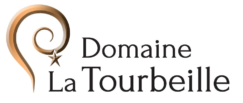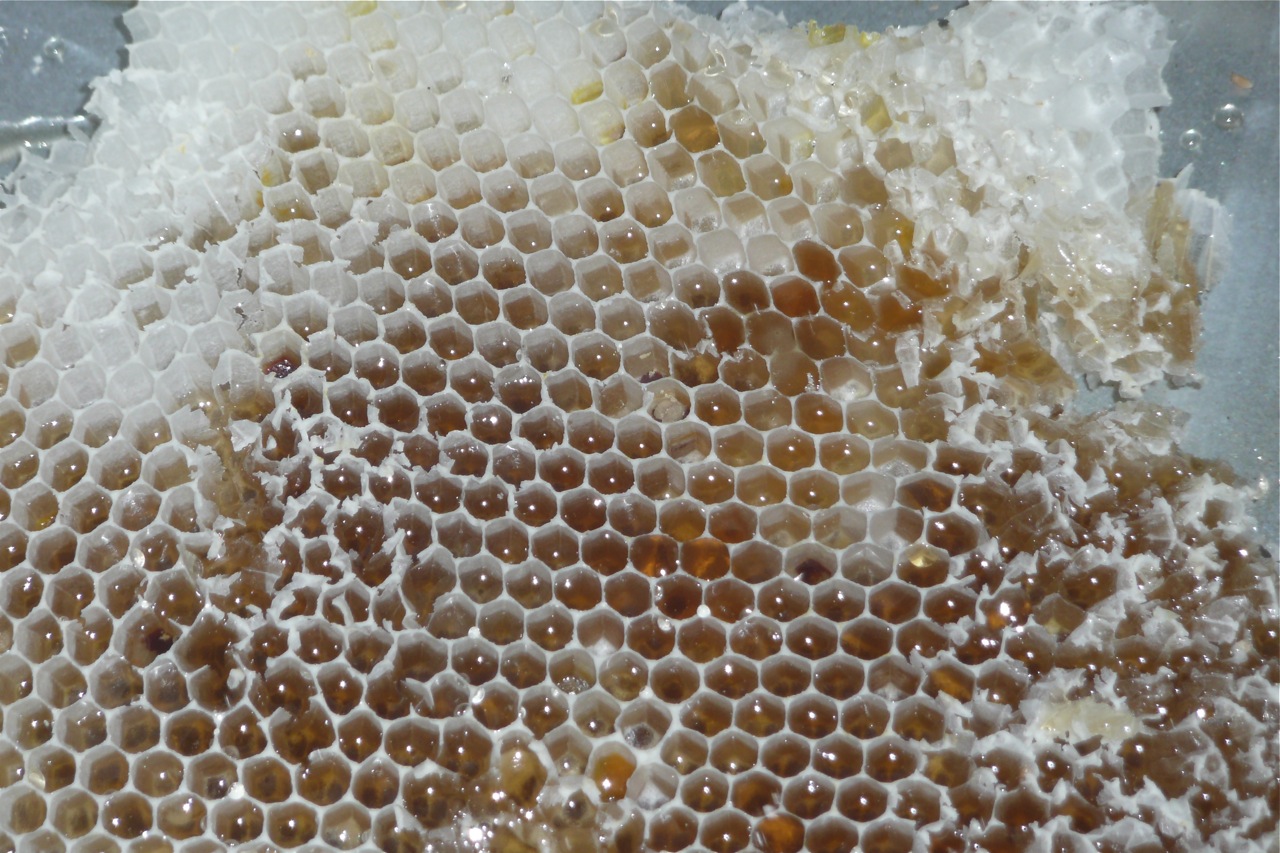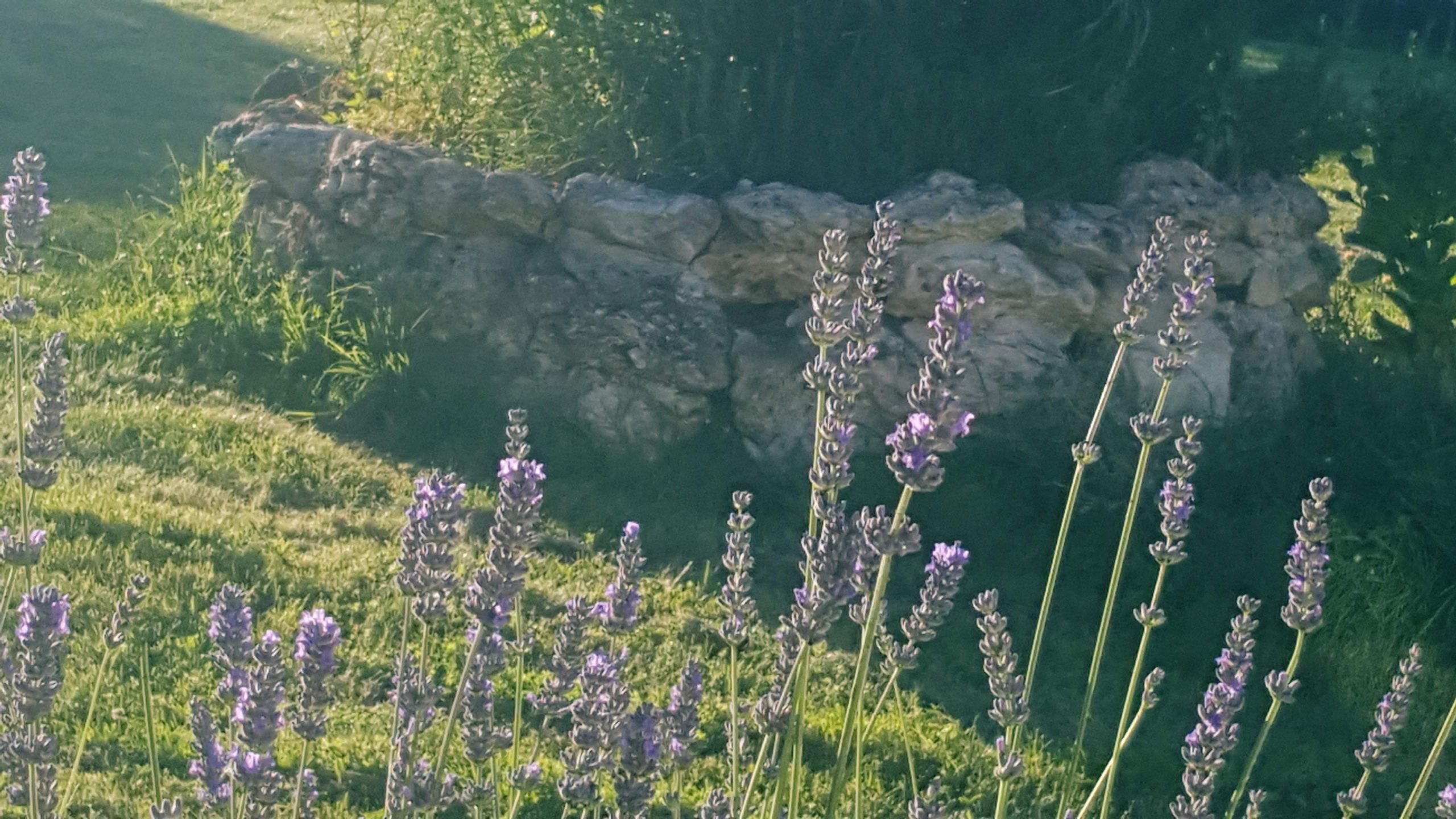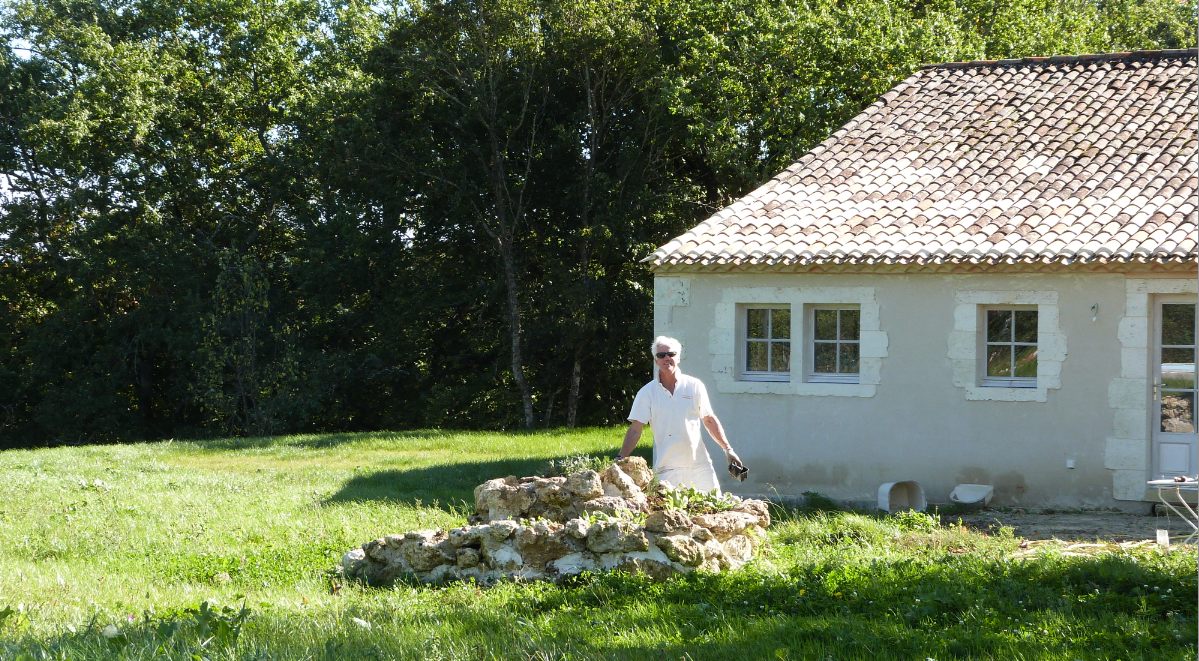It’s a peculiar thing to live in an old chateau.
The walls that envelop us are far older than the generations we can still picture in our memories. Everything – paintings, sculptures, furniture, clocks, tapestries… are impregnated with the dust and fingerprints, tastes and whims of people whose names we have lost. Some of their portraits dress the halls – the lady coiffed in a high oblong gossamer bonnet with the face of a fish wife, whose eyes followed the children so she was banished to the bibliotheque, (we recently discovered she had been guillotined) the gregarious fellow in diaphanous 18th century gentleman farmer garments with an appealingly alcoholic nose, the thick eyebrowed widow with her pursed lips and judgmental regard whose only concession is a wide pink ribbon, the worldy man in his prime years, poised, witty, his white satin cravat pinned just so with a pearl…
In the old, neglected winery, dusty barrels are stamped with the name of the owner in 1860; their family tomb is marked by three ancient boxwood trees in the field just above. And of course at the entrance drive is our small family tombstone, a throw back to the time when Protestants were not allowed in the church cemetery.
And these are just the ones whose images remain, who’ve left scratches on the surface. What to make of all the others, much older, etched away, worn away, transparent now?
Those are the ones I sense most often. The stones, walls, tiles, windows, floorboards – still contain their exhalations. Some people say a house is just mortar and rock. But on a silent winter day, when the house sits closed up and empty, I move through the rooms breathing in the familiar, musty, dusty perfume of oldness and others, and swim through an atmosphere of long ago.
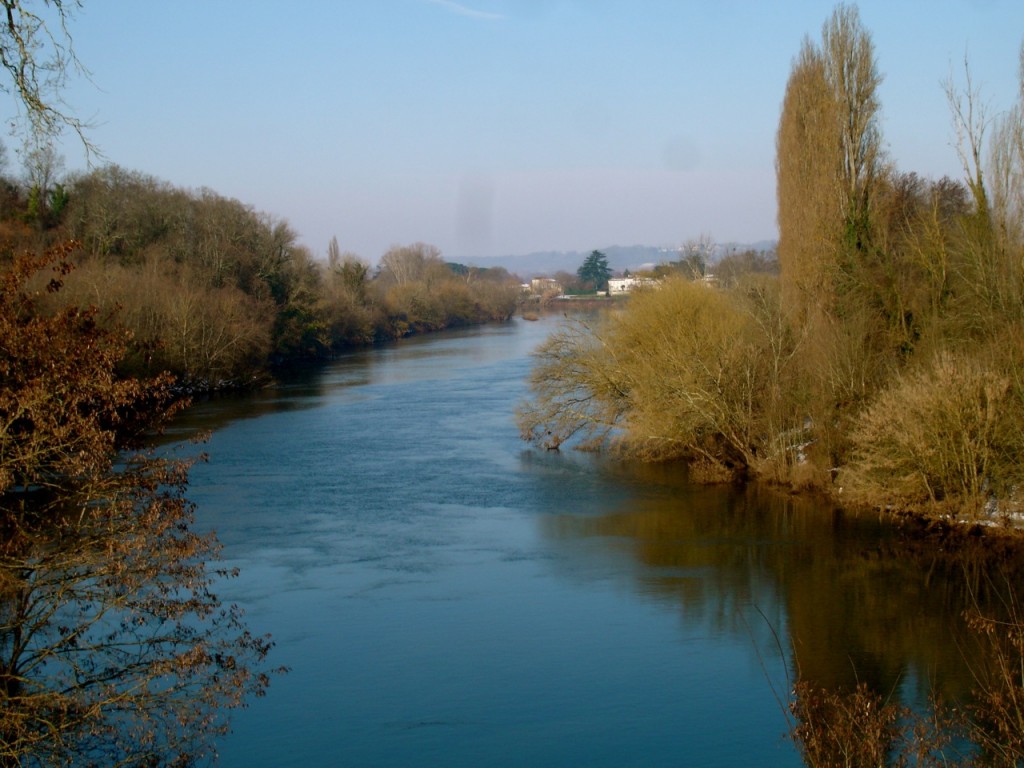
I’m sitting today at the desk in the room that was home to us through 25 years of travel and upheaval. A view of a strategic bend in the river, woods dense with wild boar and deer, gentle hills beyond on the far side of the valley. For a long time this particular room was the only place in the world where we felt roots. A child was conceived here when we had no where else to live. Whenever we returned from hither and yon, this room opened her arms, welcomed us back; a room so large we could fit the new born in a cradle, two children in their so-called “magic bed,” and collapse into a big bed just for us. The same smell of stillness, furniture polish and indigenous dust; the same comforting smell of eternity.
In summers we were surrounded by a score of family members; it was a time of elegant dinners and casual picnics, croquet and backgammon competitions, canoe excursions, marco polo in the deep end of the pool and dancing in the Petit Salon. And yet, it was in our room that we felt most at home. We would close the door and invite in the shy ghosts and mischievous fairies. Alone at Christmas we received deep mid winter dreams of the people who once lived here and seemed to walkabout still. Here we snuggled under the covers and read the children their bible stories, played cards, drank sweet jasmine tea, conjured up hopes for the future and sent up prayers for our offspring who called this place home.
Even today, when I have a little cottage of my own, I still come to work at this desk or bed myself down. Of all the bedrooms I have known, there is none like this.
Is it the high ceilings, the 18th century teal blue beams, the floor to ceiling windows, the dimensions, proportions – a room with breadth from wall to wall of the entire house, a room with no pretensions, no grandeur, no imposed deco style? Or is it the perch above the river, the countless nights listening to fish and owls, the dream state of floating on the water in the darkness, flowing down river with the night creatures. Yes… but there is something else, and I struggle to name it.
At first, I thought it was some connection to the lingering presences of previous occupants. At times I entertained the notion that I lived here in a past life.
One night, rendered sleepless by some common terrestrial distraction, I found myself pacing at the river windows, tracing circles. Like a dog nosing out the place where the energy is right for him, I found myself sending sonar probes to find mine. When the certain spot called out, I lay down on the floor. Parallel to the river, set among the trees, aloft in this room as if in a tree house, nestled in the boughs, rocking gently with some vibration, some harmonizing frequency. A sleep deep, nourishing and full of dreams.
That’s how it is. When I stretch out in this room, I expand and rise. I know this place in a part of me so deep that I go back to the cradle. I’m safe. I’m home.
* * *
Over the years, I gave up asking why. I had once hoped to unravel the mystery, but gave up after glimpsing the spectre of hubris and futility. The one known is that there is some spirit in this place. The one crucible is the challenge of getting transparent enough to be a proper conduit. The one hope is for the great good luck of becoming a vessel.
And that is where the subject of darkness comes up. One of the peculiar things about living in a chateau, whether you are owner or guest or employee, is the temptation to get caught up in the possession of a place, in getting, having, holding on. Caveat emptor. Ownership in any sense of the word can be a two edged sword. Filigree voices can dry up, retreat under beds, into floorboards, into stones, turn back into dust.
We had our first hint of this when we met descendents of the family who owned this property from the mid 1700’s to 1932. My mother in law asked me to bake American brownies for a state visit from one of them – Madame V. – a woman who sparkles with joie de vivre at the age of 95, a veritable font of oral history. She told me her grandfather boasted he could ride horse back from Bergerac to St. Emilion and never leave the family land, and lamented that her ancestors had let this jewel of a place slip out of their hands. It was her uncle G. I believe, who had a problem with gambling, and found he didn’t have enough money left to repair the roof. If you could see the roof surface here – enough to cover a football field – with roofs being the primordial repair in the preservation of centuries’ old stone buildings – you’d understand how such a thing could happen.
Madame V. became one of my favorite people. One day she loaned me a manuscript she’d found in her attic, parchment so fragile I fretted it would shred in my hands. The opening page is dated 1760. A journal! And it was written right here, by her ancestor who married the last of the family line – Mademoiselle de la Tourbeille. The thrill of holding that journal, lying in bed at night, reading anecdotes of daily life in this very place in the 18th century – I still shiver just thinking of it.
In one of our conversations Madame V. remarked that people have always been drawn to this place. We totted up some of the tangibles. Proximity to the Dordogne. The chateau itself. The confident and certain grace of this arrangement of stones pulled from the river; the manner in which they were joined, the taste that has not been violated despite the architectural whims of the past 200 years. The land. She twinkled when I insisted guests also feel spirits of the many people who had lived here, her ancestors and then some, back for hundreds of years, back to the time when a humble hunting lodge was set upon this spot, back to… back and back and back…
For whatever reason, people come and are recharged. Those who arrive tired, find repose. Those unable to sleep find a soporific. Those who cannot settle their hearts learn a new rhythm. It’s the food grown here, the spring water running under the land, the ions wafting up from the river. It’s the century old trees, the Cedars of Lebanon, the Lindens, the Oaks. It’s the wildlife protected by the impenetrable brambles and woods that surround us. It’s the rare birds, ladybugs, wildflowers; the incredible sunrises, incredible sunsets, twilights, starry nights, moonlit nights…
When the moon is full in August, the Harvest Moon, I make sure to walk about the field of the boxwood trees tomb. The newly mown land is dotted with fresh rolls of hay, iridescent in the moonlight. I press my nose into each one, take in their particular local fragrance, their warm hay sweetness. Silence. The white light and reverse shadows encourage reticent old prairie dwelling souls to let out a shy breath.
In such a place, healthy people seem to get stronger. They take what they need from the atmosphere and transform it inside themselves, become more centered. And too, in such a place, a false note rings shrill, like the intolerable squeak of a rusty hinge. You could almost say that such a place is a sort of litmus test, the way a smart dog can tell if a person is hiding something – fear, dishonesty, greed.
But who could anoint themselves readers of such things? Not I. I’ve been fooled and humbled twice too often. Only the house I think, and of course she remains silent through the époques. Or does she? Thinking about the spirit of this house and her survival through centuries of light and of darkness, I wonder what she has witnessed.
In my own allotted sliver of time here, I have noticed that the house seems to bring out or accelerate whatever the occupant seems destined to manifest.
Who can forget the secretary who came to work here, bought horses, blossomed, pursued her painting, and then left because her art was so lovely she could make it her living. Who can forget the young man who came without a purpose, who lived in the tower attic for a year, who took up the study of wine and went on to become a Chevalier of St Emilion? Who can forget the children who overcame their fears of dogs, water, spiders; who overcame their asthma, acne, terminal shyness; who learned old fashioned table manners and the art of conversation; who discovered it was ok to get muddy and set a maggot on a fishing hook.
* * *
It’s lovely to think back on those years. In a period of stability, we trust peace will last forever. One tends to let down one’s guard.
Ah. The invisibility of first fissures. The subtleties of first cracks. Who hears the first tiny pop as something breaks in the core?
I suppose it was inevitable. Villains never think of themselves as villains; they identify with the hero in the movie as we all do. And most of the time, they don’t look like bad guys at all. They can look like waifs or orphans; they can look like a good man just down on his luck, in need of a hand, or a smiling guest with an assured way of taking without asking; they can look like the son or brother of someone you trust. Aye, there’s the rub. That extension of trust through someone trusted.
At first the signs were small. An encroachment here, an indiscretion there. Then the nests of our barn swallows disappeared. Endangered species, we love them so much we give up our garages so they can make their babies each spring. But apparently the mess they leave is not worth the delight observing their antics or our pride in being one of the few refuges left in the region.
When I returned from one long absence, I found the nests summarily axed. The tiny apartments of filigree twigs were cast onto a bonfire. As the flame was lit, some delicate, intangible balance tipped. The house ghosts scattered. The fairies evaporated.
* * *
We had never considered the dilemma: how to welcome the many people who need magic places, without destroying the magic in the air? How much goodness can be breathed in; how much ill health can be exhaled, before the balance tips?
And the irony. Poison takes hold when there’s an existing fissure to explore. “Maman et Papa” were growing old, but their mirrors reflected back earlier selves, robust characters exuding power and control. We were informed summarily – “tout va bien.”
But when further events involved warnings from the bank, from the doctor, from a neighbor, we began a belated defense. Against the rising water, a few bags of sand; too little, too late. A shadow had insinuated itself into the heart of our home, a dark symbiosis, like mistletoe eating into a tree, taking up residence.
